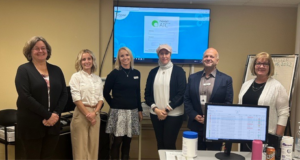This article was written by Keane Bourke for ABC News. Published June 21, 2022. To access the original article, click here.
WA health authorities are considering elective surgery “blitzes” to deal with a waitlist that has grown by 10 per cent over the last year and is keeping more patients waiting longer.
Karen Boyd is among more than 33,000 West Australians stuck on the growing public elective surgery waitlist.
She had been preparing for surgery on her spine late last year, but when her specialist decided to stop operating on public patients, Ms Boyd was sent to the back of the public queue.
Now she has been told that an appointment with another surgeon is not likely to happen until December, with surgery to take place sometime after that.
Yet Health Department guidelines recommend Ms Boyd be left waiting no more than a year.
“I do suffer most days with it, in one way or another,” she said.
“Within the last 12 months it has deteriorated, so I would only imagine that it will deteriorate a lot more over time.”
COVID impacts surgery waitlists
In the last year, the waitlist has grown from 29,980 cases to 33,206 – a jump of 10 per cent.
That is due in part to elective surgeries being paused at various stages to help hospitals manage pressure, and more recently because of staff furloughed by COVID.
But worryingly, the number of patients waiting more than the recommended time for their surgery has also increased, from 8 per cent to 20 per cent.
“That means diseases progress,” Australian Medical Association WA president Mark Duncan-Smith said.
“There’s also the psychological consequences on patients, who know they need the surgery but they can’t get it.”
In the most serious cases, classed as category one, 26 per cent of cases had not been seen within the recommended time of 30 days, compared to 9 per cent a year ago.
“There has been a slight increase because we are in the middle of a COVID surge,” was Health Minister Amber-Jade Sanderson’s response when asked in state parliament about the increase last week.
“Over the month of May we had 3,300 staff furloughed. That is why. We had a short, sharp, planned six-week scale-down of elective surgery.”
That is despite Health Department figures showing the number of “over boundary” cases steadily growing over the last year.
Elective surgery ‘blitzes’ being considered
This week New South Wales, which is also juggling a budget $11.3 billion in the red, announced it would put $400 million towards clearing the state’s elective surgery backlog.
That would be done by increasing staff and making operating theatres available on evenings and weekends.
The head of WA’s health system, David Russell-Weisz, revealed in budget estimates yesterday that WA was thinking about doing the same.
“We are considering — as staff furlough gets better — short, sharp, what I would call blitzes,” he said.
“We are considering having theatre times at weekends, or extended hours, all of that is considered by the health service providers.
“But they obviously are working with a system that has significant emergency demand and still significant staff furlough.”
Dr Russell-Weisz said ensuring elective surgery waitlists did not get worse would be “a constant theme” for WA Health in the years to come.
Urgent action needed: opposition
Opposition health spokeswoman Libby Mettam said the government was not moving fast enough to tackle the growing issue.
“If New South Wales can provide some urgency to addressing their elective surgery backlog, then surely the McGowan government, who are sitting on a $5.7 billion surplus, can do the same,” she said.
She pointed to a growth in elective surgery waitlists, from around 15,000 when Mr McGowan took office to the more than 30,000 case backlog now.
“Unfortunately, it’s WA patients who will ultimately pay the price of a government who continues to ignore the elective surgery backlog, which has continued to grow since 2017,” she said.
“The real concern here is that there will be other impacts on acuity levels and it will see other issues come up, because patients aren’t being treated within an acceptable time frame.”
In a statement, a spokesperson for the Health Minister said WA was in a different position from other states, because its Omicron wave came later.
“We continue to experience staff furlough and hospitalisations due to COVID-19,” she said.
“However, each of the health service providers is looking at ways they can safely reduce elective surgery waitlists.”
Wages policy in spotlight
Dr Duncan-Smith said regardless of the government’s plans, more staff would be needed.
And with both New South Wales and Victoria offering health workers $3,000 bonuses, he expected attracting people to WA would be difficult.
“If [WA Health] don’t keep up with the other states, there’s a good chance that we won’t get that recruitment, and in fact we may even lose doctors and nurses from Western Australia,” he said.
The government appears to be standing firm on its wages policy, which caps increases at 2.5 per cent a year, plus either a $1,000 sign-on bonus or an extra 0.25 per cent per year, as agreed to by unions.
“The state government’s wages policy is set,” Ms Sanderson’s spokesperson said.
“We continue to look at ways to better support our staff, and recruiting additional staff is a significant focus for us.”
On Monday, the state’s public school teachers agreed to a 2.75 per cent increase under the policy, despite having earlier asked for a larger rise.
Ms Sanderson yesterday told parliament there had been a net increase in the health nursing workforce between June 2020 and May 2022 of 12.8 per cent, with the medical workforce increasing by 13.5 per cent.
Patients urged to keep asking
For those on the waitlist, the head of WA’s Health Consumers’ Council Suzanna Robertson said it was important to ask questions.
“Keep contacting [your doctor] and saying ‘where am I on the list now, what’s the criteria, who do I need to talk to, do you need a new referral?'” she said.
“Keep people appraised if your situation is deteriorating [and] make sure that you are accessing services and supports in the meantime.”
Ms Robertson also said it was important to remember that elective surgery did not mean patients were waiting without consequences.
“It’s impacting potentially their mental health, their ability to care for themselves, their ability to care for others, their ability to work to their usual capacity or at all,” she said.
“So it’s really important if we can, to link them up to other services while they’re waiting to make sure they have the best quality of life possible.”
That is little comfort for Ms Boyd though, who still faces a six-month wait to first meet with her new surgeon.
“I don’t work, I can’t work at the moment,” she said.
“I’m on medication, that medication is taking away some of the pain, but I only have to bend down [and] it’s an issue getting back up again.”



